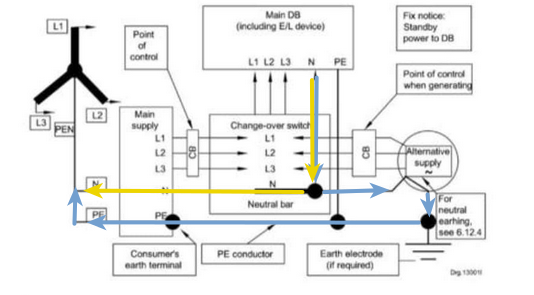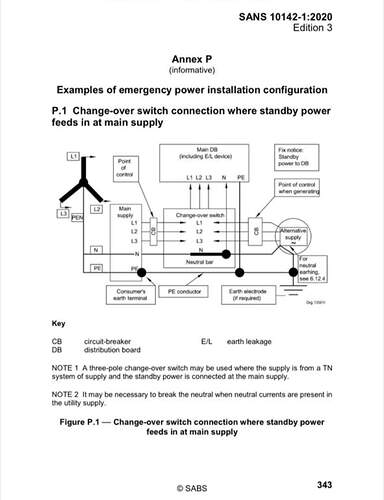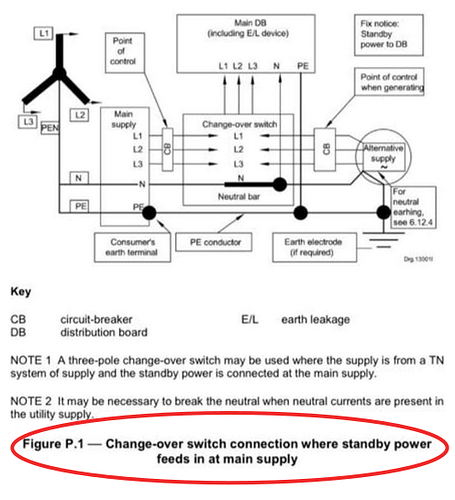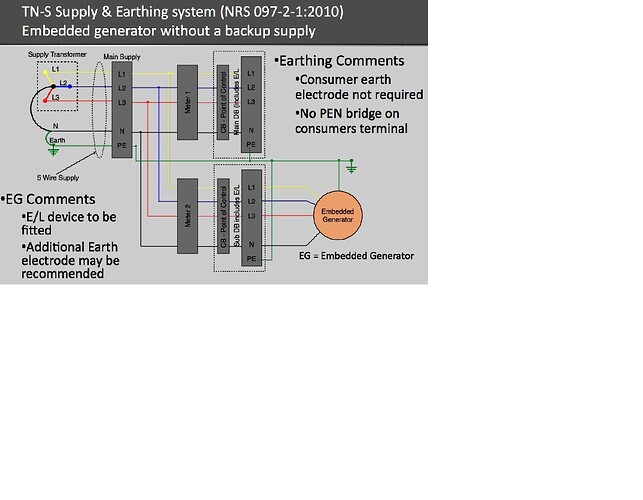i have a solar installer telling me that the new SANS requirement is to have a permanent neutral bond, is that true, can someone enlighten me please.
That’s extremely vague…
There is already a permanent TN bond, either at the transformer (TN-S) or where the cable enters your premises (TN-C-S).
There is also a rule that you are not allowed to make a second TN-bond elsewhere in the installation, and you are not allowed to treat a neutral as if it is also earth (which you may, in a TN-C connection, but not here), and you also may not treat an earth as if it is also neutral. That means no bond on the output of the inverter while it is connected to the grid.
But once islanded, a new bond has to be made, so presently all the approved inverters have bonding relays or an external bonding arrangement to effect such an islanded bond.
Now I’m not quite sure which part this sparky is saying is changing. Is he saying you are now allowed to bond TN on the output of inverters permanently, doing away with the bonding relay requirement? Because I rather doubt that, unless someone can show me the text ![]()
Lots of installers are already doing this with SunSynk and Deye, some of them even know it’s illegal.
Yes, that is exactly what this particular installer is doing, bonding neutral and earth permanently on the output of the inverter, guess they are saving a few hundred bucks and 10 minutes of work.
This installer says he will send me this article, will wait and see.
Please share as soon as you have the article. I am with plonkster on this one…
There are some that has other interpretation due to the inverter being an alternative source, effectively ignoring the internal workings of the inverter…
There is one time you are allowed to do this (to my knowledge), but that does not apply in the bulk of cases.
If the inverter is installed at the point of entry such that it backs up the entire installation (not just a part of it), then you are allowed to use the “upstream” TN bond and bridge the neutrals to have another TN bond. Then you don’t need the bonding relay on the output. To my knowledge, this is the ONLY exception, and I am not even 100% sure about that… but since most installations backs up only a part of the installation, it’s usually a moot point arguing about this possible exception.
Sometimes I think the main reason people are okay with this sort of thing, is because we were told that electricity “takes the shortest path” (which surely should be the neutral here, right?). No. Electricity takes all paths. It just takes more of the shorter (lower impedance) path, that is, the age old “road to hell is wide and easy” analogy, but some do take the road less traveled… wow, that was a double literary reference ![]()
Edit: May comment above was wrong and is now corrected. You are not allowed to rely on the upstream TN bond.
7.12.3.1.1 Protection in accordance with the requirements of 6.7 shall be
provided for the electrical installation in such a manner as to ensure correct
operation of the protection devices, irrespective of the source of supply or
combination of sources of supply. Operation of the protection devices shall
not rely upon the connection to the earthed point of the main supply when the
generator is operated as a switched alternative to the main supply.
You may however have a second bond on the generator in this case. As shown in Annex S.1.
@plonkster , the above is what the installer sent me
6.12.4 Earthing of the neutral of combined sources
When an installation that has a common neutral is supplied from a
combination of transformers and generators located near one another, the
neutral terminal of each of these items shall be connected to a single neutral
bar. This neutral bar shall be the only point at which the neutral of the
installation is connected to the consumer’s earth terminal except as in the
case in 7.12.3.1.3 or 7.16.4.
7.12.3.1.3 Where alternative supplies are installed remotely from the
installation, or from one another, and where it is not possible to make use of
a single neutral bar or neutral conductor which is earthed, the neutral of each
unit shall be earthed at the unit and these points shall be bonded to the
consumer’s earth terminal (see 6.12.4). The supply from each unit which
supplies the installation or part of the installation, shall be switched by
means of a switch that breaks all live conductors operating substantially
together (see P.2 and P.4), to disconnect the earthed neutral point from the
installation neutral when the alternative supply is not connected (see also
6.1.6).
NOTE Where four pole switching is implemented, consideration should be given to
use overlapping neutral switching devices.
7.16.4 Neutral earthing
7.16.4.1 Whereas TN-C systems may be implemented along the distribution
system backbone, the individual service connections at every distribution
kiosk shall be TN-S.
7.16.4.2 From the point of supply to each user or part of a communal
installation, the neutral and earth conductors shall be separate conductors.
7.16.4.3 Wherever the neutral is connected to the earth, a warning notice
shall be fitted to the outside of each distribution kiosk in the distribution
system, indicating “Neutral earthed inside”.
7.16.4.4 A clear notice shall be fitted at the combined neutral-earth
connection inside each distribution kiosk in the distribution system, that
prohibits the removal of this connection while the supply is alive, or might
become alive.
7.16.4.5 The neutral shall not be earthed beyond any earth leakage unit.
7.16.4.6 A TN-S system shall not be converted to a TN-C system.
I also need to add, this is not a “new” ruling. It’s been in there for over a decade ![]()
The trouble is this. That path I drew in blue, that’s working current running on an earth wire.

As I understand it, this is okay if the supplies and their earth point come together at the same location, at the connection point of the installation. Note that a “consumer’s earth terminal” is also shown there, suggesting that this is totally illegal in a TN-S system where the earth terminal is up the street at the transformer.
Edit:
The supplies must be “close” to each other.
6.12.4 Earthing of the neutral of combined sources
When an installation that has a common neutral is supplied from a combination of transformers and generators located near one another, the neutral terminal of each of these items shall be connected to a single neutral bar. This neutral bar shall be the only point at which the neutral of the installation is connected to the consumer’s earth terminal except as in the case in 7.12.3.1.3.
If we then head over to 7.12.3.1.3:
7.12.3.1.3 Where alternative supplies are installed remotely from the installation, or from one another, and where it is not possible to make use of a single neutral bar which is earthed, the neutral of each unit shall be earthed at the unit and these points shall be bonded to the consumer’s earth terminal (see 6.12.4). The supply from each unit which supplies the installation or part of the installation, shall be switched by means of a switch that breaks all live conductors operating substantially together (see annex S), to disconnect the earthed neutral point from the installation neutral when the alternative supply is not connected (see also 6.1.6).
In other words, you can TN bond a UPS (which disconnects the neutral when the grid is alive), but you cannot do it with a grid-tied inverter like a Sunsynk or a Victron Multiplus running ESS.
In the picture above, the two “point of control” CBs are technically not allowed to be active at the same time. That picture is for a backup generator.
@Rautenk and @JacoDeJongh ?
I am sticking to spending a couple of hundred Rand for the contactor and about 10 minutes of labor !!!,
It is regulation and has to be done.
The engineer should not have signed with it not being in place. Without it, your earth leakage would not trip like it should.
Curious what people are thinking when they want to take shortcuts with these things.
Bad earth neutral bonds give you…
- Floating neutral and often floating earth… If you like everything in your house that has a metal enclosure to bite…
- Very likely either your earth leakage won’t work at all… Or you will end up with multiple paths - nuisance tripping…
All considered, it’s just dangerous and likely to hurt people and damage appliances.
To @plonkster 's point on being close to source… We had an issue at an old house where the Eskom earth was actually 40V higher than the earth spike at the house… Means that if you connect that earth you end up paying for using no electricity…
Sunsunk Inverters use an 220VAC output called ATS which energises only when the Grid falls away. This output energises a relay which connects the Neutral to an earth spike preventing neutral float. This is not permanent bonding and is entirely legal in South Africa where a permanent neutral bond is illegal.
Yup. The rumour I heard is they added that in firmware because the Saffers asked for it. And it is indeed perfectly legal. Then another rumour has it that the ATS output relay sometimes has a failure and that may leave it unbonded. Unlike other brands that test the bonding relay, this may go unnoticed. Hence, it was recommended here to add a low power light/noise-maker between T and N (before the RCD!) so that such a failure becomes immediately apparent.
I am not sure exactly what the history of this is. Oddly enough, when I bought my Deye inverter, it did not have this (although the Sunsynk did). I explained the issue to the Deye engineers in China. At first they did not understand why such a thing would be required, but once I did, they said ‘OK’ and 3 days later pushed an OTA update to add it.
So this is definitely not a feature that is used in many markets.
Yes I know, but I have seen many installations where the installers simply installed a permanent bond. It seems to be the de-facto standard with SunSynks.
Islanding is not really a feature used in many markets, in most places islanding would be an exception, not a daily occurrence.
I just had a conversation with Leon Ross at AIA, according to him, they recommending a permanent neutral-earth bond, unless an inverter has one internally, which can be monitored.
Also, that this will be coming out in the next edition of SANS


